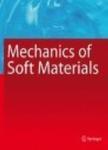版权所有:内蒙古大学图书馆 技术提供:维普资讯• 智图
内蒙古自治区呼和浩特市赛罕区大学西街235号 邮编: 010021

作者机构:James T. Willerson Center for Cardiovascular Modeling and Simulation The Oden Institute for Computational Engineering and Sciences Austin USA The Department of Mechanical Engineering The University of Texas at Austin Austin USA The Department of Biomedical Engineering The University of Texas at Austin Austin USA
出 版 物:《Mechanics of Soft Materials》
年 卷 期:2025年第7卷第1期
页 面:1-39页
摘 要:In this review, we explore the development of the structural constitutive models for soft biological tissues and biomaterials, focusing on the role of mechanical interactions. Soft tissues, such as myocardium, heart valves, skin, and other fibrous biological structures, display complex, non-linear mechanical behaviors driven by their fibrous composition. While traditional constitutive models have been widely adopted to describe the anisotropic and hyperelastic nature of these tissues, they often fall short in capturing the detailed mechanical interactions between fibers, the ground matrix, and other tissue components under diverse loading conditions. To address these gaps, we focus on the development of meso-structural models that account for mechanism-driven fiber-matrix and fiber-fiber interactions. We delve into the kinematics of these interactions, highlighting the roles of fiber rotation, extension, and shear, and how these mechanisms differ across various tissues and biomaterials. Our review draws on experimental evidence from studies on exogenously crosslinked tissues, myocardium and electrospun polycarbonate urethane biomaterials, which reveal the presence of significant mechanical interactions that influence the overall stress response. In addition, we also discuss recent advancements in computational methods for implementing these models, particularly neural network-based approaches that mitigate the computational challenges typically associated with structural models while maintaining high predictive accuracy. Finally, we propose future directions for multiscale modeling to enhance our understanding of fiber network topologies and their mechanical roles in both native tissues and biomaterials.